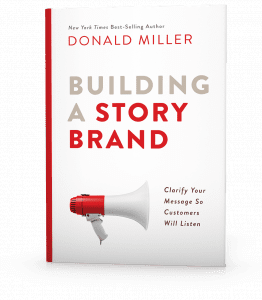Why trying to be a HERO might be costing you clients

Every now and then I run across a brilliant book that fits in the category of, “Darn. I wish I had written this!” Allow me to introduce you to a book that would be well worth your investment of time and a few dollars, as it is almost guaranteed to make you look at your business through a different lens: Building Your Story Brand by Donald Miller (HarperCollins, 2017).
As the title suggests, the author – Donald Miller – puts his ideas in the framework of stories, drawing numerous examples from movies to bring his ideas to life. The book walks readers through the “seven universal story points” that all people respond to, ultimately helping the reader clarify their brand’s message so that their clients, prospects and centers of influence will actually listen. It truly is a game-changing book, and below are a few of the most powerful concepts that I took away from reading it.
The Hero, the Guide, and the Villain
In the book, Miller explains that most successful movies use the characters of the “Hero” and the “Guide.” In the early Star Wars movies, Luke Skywalker was the Hero and Yoda was the Guide. Miller recommends that you want to position yourself as the Guide and allow your prospects and clients to be the Heroes of their own stories.
Without a doubt, too many businesses set themselves up as the Hero. They confuse establishing their credibility (which they should do at the right time) with making themselves the hero or star. In Building Your Story Brand, Miller helps the reader learn how to talk about their prospects’ and clients’ problems using the same tools screenwriters use: the villain-hero conflict.
Miller starts this conversation using movie examples such as Darth Vader (Star Wars), Voldemort (Harry Potter), and Kryptonite (Superman). The villain is something external to us and our business. Writes Miller, “Frustration, for example, is not a villain; frustration is what a villain makes us feel. High taxes, rather, are a good example of a villain.”
One common villain in your story and mine is this: the barriers to reaching ideal prospects, such as marketing-message overload, the Do Not Call regulations gatekeepers, etc.
2 Levels of Problems
Writes Miller, “The villain is the antagonist because the villain causes the hero serious problems….” I would contend that since growth comes from solving problems, the villain is the catalyst to the hero’s growth. No problem, no growth.
As we think in terms of gaining the attention of our ideal prospects through the problems we solve, there are two levels of problems we need to address when we communicate our value to others: external problems and internal problems.
- External Problems are the barriers that the villain puts in the way. So, if the villain is the barriers to reaching people, then the external problem is: Not seeing enough quality prospects who turn into ideal clients. But, speaking to only the villain and/or external problem is not enough…
- Internal Problems tend to be emotions that people experience because of the external problem. These include emotions such as frustration, self-doubt, anxiety, fear, denial, and intimidation. Miller makes a good case that someone’s “… internal desire to resolve a frustration is a greater motivator than their desire to solve an external problem.”
Some Examples
Here are a few examples of external problems that cause internal problems. Notice how most of the internal problems come down to a few common emotions.
Commercial Banker’s Prospects & Clients
- External Problem – “How do I get the best interest rate?” “Can I qualify for a large enough loan?”
- Internal Problem – Confusion, worry, fear
Financial Planner’s Prospects & Clients
- External Problem – “There’s so much conflicting information coming at me all the time.”
- Internal Problem – Confusion, anxiety, denial, inaction
Real Estate Agent’s Prospects & Clients
- External Problem – “I’m not sure who I can trust to make sure I get the best deal possible.”
- Internal Problem – Worry, slow to take action
Business Consultant’s Prospects & Clients
- External Problem – “I have to get my company more profitable… soon!”
- Internal Problem – Anxiety, fear, doubt, stress
B2C vs. B2B
It’s important to note that this concept of External and Internal Problems works equally well in both B2C and B2B scenarios. Remember, even the largest corporations are simply made up of people! So, whether your prospect is making a buying decision for themselves or representing a large company, the same rule applies: the more you can understand about the external and internal problems that they face, the more effective you’ll be at gaining their interest and earning their business.
When you’re speaking with your corporate contacts, discuss how the company problems are affecting them personally; discover the impact of the problem on the company, as well as the impact of the problem on them. Quite often, the best way to elicit both levels of problems is to make statements or ask questions that demonstrate that you know their world.
For example: “It’s pretty common for folks to feel inundated, and even a bit confused, by the sheer volume of conflicting information that comes from many different sources. Is that something you’ve experienced?”
COMING SOON: Radical Relevance
 To be able to create relevant and compelling messaging, it’s absolutely critical for you to understand both the External and Internal Problems faced by your prospects and clients. In my upcoming book, Radical Relevance, I give you the tools to create messaging that is so targeted that our prospects see themselves in the story we tell, and examples we provide. They see that they can go from problem to solution with our guidance. But, don’t wait for the book to be published to get started implementing the principles of Radical Relevance! Check out my newest YouTube video:
To be able to create relevant and compelling messaging, it’s absolutely critical for you to understand both the External and Internal Problems faced by your prospects and clients. In my upcoming book, Radical Relevance, I give you the tools to create messaging that is so targeted that our prospects see themselves in the story we tell, and examples we provide. They see that they can go from problem to solution with our guidance. But, don’t wait for the book to be published to get started implementing the principles of Radical Relevance! Check out my newest YouTube video:
[arve thumbnail=”11941″ play_icon_style=”none” width=”480″ height=”270″ src=”https://www.youtube.com/embed/7FmuDgdFF6g” frameborder=”0″ allow=”autoplay; encrypted-media”]





